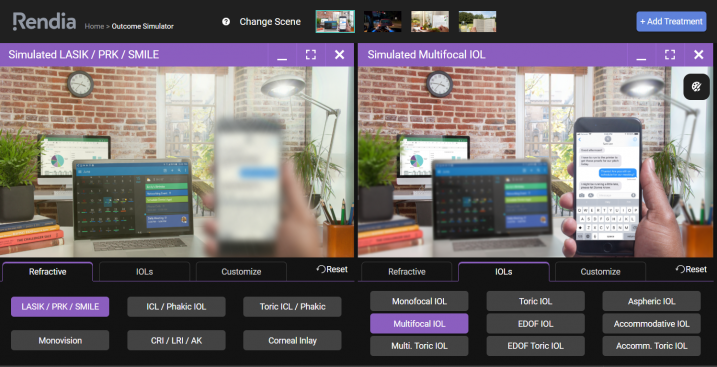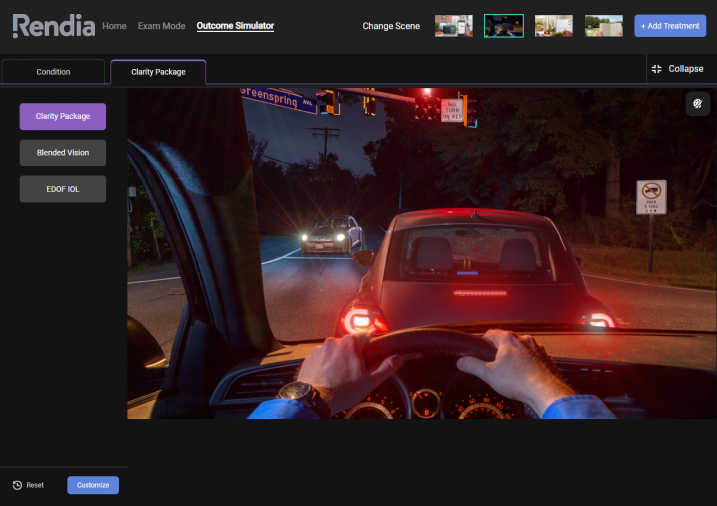How doctors are using this advanced tool to educate patients and increase conversions
You’ve likely heard the expression “you have to see it to believe it.” How about “a picture is worth a thousand words”? These sayings certainly prove true when it comes to patient education for eye surgery. Time and again, doctors tell us that Rendia’s Outcome Simulator helps them show patients what they can expect from certain procedures in a more impactful way than simply telling them.
“I use the Outcome Simulator tool for all of my cataract and refractive surgery consultations to simulate unaided vision and possible treatment options to help patients make the best decision,” said Dr. Edward Meier at Apex Eye in Ohio.
Customized simulations can help cataract and refractive surgery patients and their families see the expected outcomes of various procedures compared to their current vision.
Rendia’s Outcome Simulator is the most advanced vision simulator on the market. Here are some key features:
Customizable to each patient. You can personalize what each patient sees by demonstrating their current visual acuity along with different simulated outcomes, so that patients can get a true picture of their vision, before and after treatment. Plus, settings aren’t fixed—you can emphasize residual astigmatism or nighttime halos, for example, to show the range of possibilities.
You can save customizations, including specific treatment labels for the different lens options. You can use your practice’s preferred terminology—whether that’s the IOL brand name or your own package name like “Clarity.”
Relatable and realistic. Show patients realistic scenes by using the tool’s high-quality images of an office environment, driving at night, or reading a book, so that patients can easily picture how they’ll see in different situations.
Fast and intuitive by design. Outcome Simulator loads and responds quickly. We’ve extensively tested the tool with customers to ensure that sliders and buttons are easy to find and understand so that you can make comparisons in an instant.

“It’s very helpful with patient education, and can simulate what the vision should be like after cataract surgery with different types of lens and helps them make a final decision on which lens would fit their lifestyle,” said Tanaeya Hovington at Duke Eye Center.
Demonstrate the value of premium options
In order to get the best results possible and improve their quality of life, patients need to understand the value of various treatment options or elective add-ons before opting in. And doctors need to effectively convey to patients how options will enhance their lifestyle in a way that resonates.
Outcome Simulator lets you quickly compare treatment options for any simulated condition. Let’s say you have a cataract patient who has indicated in her lifestyle questionnaire that she’s always losing her reading glasses and enjoys writing book reviews on her computer. She’s a strong premium IOL candidate, except that she enters your practice intending to only get what’s covered by Medicare.
Using Outcome Simulator, you choose the office scene and show the patient what her computer could look like with the monofocal IOL compared to the trifocal IOL. As you compare the two options, the superior intermediate and near vision with the trifocal is obvious. Your patient begins to see the impact the trifocal could have on her daily life compared to the standard IOL: less dependence on glasses to do her computer work and read small text.
Use Outcome Simulator with spouses and caregivers to show them what the patient’s vision looks like and get their buy-in on treatment decisions.
Plus, you can use the visual simulations to help a spouse or family member empathize with the patient’s vision problems and get their buy-in as well, either by showing them during the appointment, or emailing a video that the patient can watch with their family at home later.
Set realistic expectations
You want patients to experience realistic outcomes that exceed their expectations. Inadequate informed consent and inadequate patient education were among the top contributing factors in malpractice cases where doctor-patient communication breakdown was to blame, according to industry data. For some practices, Outcome Simulator is a risk management tool.
“Many patients who sue claim that their surgeon didn’t give them enough information about the operation or didn’t give enough time to decide whether the operation was right for them,” according to the American Academy of Ophthalmology. Tools such as patient education videos and simulators can help doctors provide information to patients that is easily understood and can be shared with family members and caregivers.
Showing patients possible side effects or “worst-case scenarios” can help them make informed decisions, manage expectations, and ensure the best result.
Doctors can use Outcome Simulator to give patients the confidence to make informed treatment decisions while managing their expectations so that they don’t make erroneous (and preventable) assumptions. You can show patients realistic depictions of possible side effects, such as glare.

Dr. Marwa Adi at Washington Eye Physicians & Surgeons in Maryland said, “I particularly like the demo of starbursts and halos. It helps with counseling for multifocal and EDOF IOL.”
Making interactive visuals part of a comprehensive informed consent process will manage expectations and get you and your patients on the same page. For example, do your patients believe that LASIK “wears off”? Don’t wait until they develop presbyopia and then tell their friends or worse, write you a bad review, saying that the LASIK didn’t last. Instead, use the surgery consultation as an opportunity to help patients understand and anticipate future changes to their vision, such as presbyopia and cataracts. Doing so addresses misconceptions up front, laying the foundation of a relationship for lifelong eye health.
An investment in your practice’s future
Doctors who use Outcome Simulator report that it’s easy to use and patients love it. At this time in health care, it’s imperative to educate your patients, build trust, and keep them engaged and satisfied. Investing in technology that helps your practice do so is a smart move.
Said Dr. Meier, “With just one converted patient, I’ve already seen a return on my investment in Rendia.”
Learn more about Outcome Simulator!

